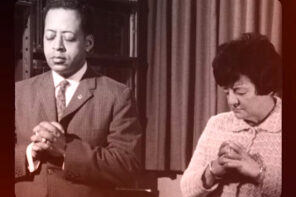We like to downplay our fascination with the apocalypse. When it shows up in pop culture, we treat it as metaphor: an alien invasion represents our fear of immigrants, zombies our fear of pandemics, and so on. Or else we’re dismissive: when Harold Camping predicted Christ’s return on May 21st, many treated him as a figure of fun, a cartoon prophet with a placard.
And yet The End is perhaps the most persistent theme, well, ever, suggesting that we need to take it seriously—and not simply in terms of cultural criticism. We ignore the apocalyptic mindset at our peril, as millennial movements have a tendency to end in bloodshed, to the point where they create their own localized apocalypses.
It would likewise be a mistake to read the longing for The End solely as a religious phenomenon. In his new book, Heaven on Earth: The Varieties of the Millennial Experience, Richard Landes, a Professor of History at Boston University, presents a gutsy hypothesis: that many secular movements—the French Revolution, Marxism, Nazism—can be better understood as millennialist or apocalyptic.
But before Landes investigates the movements themselves, he defines his terms—which, by his own admission, are “idiosyncratic.” By “millennium” he does not mean a specific date, like 2000 C.E. Instead he means “the period of the messianic era”: for example, the Christian prophecy of Jesus’ thousand-year reign, perversely echoed by the Nazis’ “Thousand-Year Reich.” “Apocalyptic” refers to “a sense of imminence about the great upheaval and the scenario whereby we now go from this evil and corrupt world to the redeemed one.”
Every millennial group, whether religious or secular, is marked by the transformation of “normal time” to “apocalyptic time”—when its followers eagerly anticipate the millennium, seeing signs and symbols everywhere in a state of “semiotic arousal” (similar to the way intellectuals are stirred by reading Umberto Eco to one another.)
Landes envisions the historical treatment of apocalyptic time as a barnyard, achieved only when “roosters” (messianic or prophetic figures, like Jesus or Mohammed) win over the public. However, the historical influence of roosters has been dismissed or downplayed (like that of self-proclaimed messiah Sabbatei Tsevi—until Gershom Scholem came along), since their stories are usually recorded by anti-apocalyptic “owls.” “Bats” are the subsequent historians who blindly believe the “owls,” while “turkeys” are historians like Landes himself, who watch “as roosters crow and observe their electrifying impact on other animals.”
As may already be obvious, the terms are apt, but their proliferation is distracting. Even for what is essentially an academic work, the taxonomy is overdone. I kept having to return to my notes to remember which animal was which, and it gets confusing when Landes refers to Chicken Little as a rooster.
Heaven on Earth gets interesting when Landes applies these terms. The story of the nineteenth-century Xhosa Cattle-Killings, for example, is downright fascinating. For the Xhosa, a millennial movement sprang up (as they often do) during a time of great societal tension—in this case “the brutal incursions of European imperialism.” Apocalyptic time began with a rooster named Nongqawuse, a fifteen-year-old orphan. In 1856, she prophesied that if the Xhosa slaughtered their own cattle, stopped planting crops, and destroyed their grain stores, the British would leave, and peace and plenty would return to the land.
Most readers will not be surprised to learn that the plan was a failure. But the majority of Xhosa didn’t survey the wreckage and say, “What were we thinking?” They just slaughtered more cattle.
The Cattle-Killings demonstrate how reluctant we are to let go of apocalyptic time. For some, like one Xhosa chieftain, admitting error would bring dishonor, though more often we simply don’t want to lose the “inebriating sense of empowerment.” For the Xhosa, cognitive dissonance, or the confusion that arises with apocalyptic disappointment, is often rationalized away with a form of prophetic improvisation that Landes calls “apocalyptic jazz.” Thus many Xhosa claimed that a time of plenty and autonomy had not returned because they hadn’t slaughtered enough cattle.
We may be tempted to dismiss the Cattle-Killings as superstitious or primitive, though millennial patterns appear just as frequently in self-proclaimed “rational” cultures. The reason we don’t tend to see it that way, Landes argues, is that the “anti-religious discourse” of historians has caused them to miss “the parallels between religious millennialism and the ideology of the Enlightenment.” While medieval Christians looked to God to bring peace and equality to the social order, Enlightenment thinkers like Kant believed that the application of reason would bring freedom and “maturity” to mankind.
When applied to the French Revolution, the religious parallels are striking. To an arguable extent, Enlightenment ideas formed the basis of the French Revolution. After the Revolution, of course, reason and fraternité did not prevail—there was hoarding during food shortages, the provinces were restive, and many religious people clung to their practices. Like the Xhosa, the leaders of revolutionary France did not give up when faced with apocalyptic disappointment. Unlike the Xhosa, the French turned to human slaughter. If the Revolution was not enough to free mankind, the “coercive purity” of the guillotine would finish the job.
Landes estimates that by end of the Reign of Terror, “some four hundred thousand French, men, women, and children, monarchists, revolutionaries, and bystanders, lay dead.” Still, apocalyptic time continued until the messianic figure of Napoleon was defeated in 1815.
Once the scales fall from your eyes, as it were, you see millennialism all over the place. Heaven on Earth includes an illuminating chapter on the “political religion” of the Nazis, and another on “Marx the Rooster,” grinding away at his “scientific” visions while his family starved. Landes also provides a dense but informative chapter on the Taiping Rebellion of China, a mid-nineteenth century, quasi-Christian movement that left some twenty million corpses in its wake.
Heaven on Earth is less illuminating of more recent movements. For Landes, UFO cults and movies about UFOs are interchangeable expressions of millennialism. I suggested earlier that we need to pay attention to the influence of apocalyptic fantasies on popular culture, but there’s a difference between belief and the suspension of disbelief, between the Raelians and Steven Spielberg’s Close Encounters, which sought only to capture our imaginations and some cash.
Landes’ discussion of “enraged millennialism” or global jihad is problematic as well, focusing on Muslim shame, which, he contends, began when the unbelievers of Mohammed’s day mocked the prophet. The Modern Era, in Landes’ telling, brought the “four humiliations of modernity—Western superiority, Israel’s existence, women’s liberation, and globalization,” resulting in the bloody, triumphalist fantasies of apocalyptic jihad.
While apocalyptic jihad does indeed pose a serious threat, Landes’ narrative reads like warmed-over Bernard Lewis. While we can’t completely dismiss this narrative (Christian apocalyptic texts, from Revelations to Left Behind, can be read as revenge fantasies), it’s just a little too neat, and it reeks of Western triumphalism. Thus Landes is not explaining, he’s explaining away. He seems to be saying that Muslims have been touchy since the very creation of their religion; of course they hate us.
So I remain dubious when he argues that after the 2000 Intifada, “almost every apocalyptic trend went mainstream in the Muslim world.” The trends that he identifies are inarguably on the rise—hysterical anti-Semitism, suicide terrorism, the dark rhetoric of martyrdom and jihad. But his conception of the “Muslim mainstream” is garnered mostly from Youtube clips, speeches by radical clerics, and translations from the Muslim media by MEMRI and Palestinian Media Watch—organizations with a decidedly Zionist bent.
I don’t use “Zionist” as a dirty word; nor would I downplay the disturbing examples of genocidal or paranoid rhetoric that Landes cites, like the charter of Hamas, for example. It is, however, important to emphasize that when it comes to Islam the author favors the us against them “clash of civilizations” model favored by Bernard Lewis and Samuel Huntington. I suppose Landes would call me an ostrich.
Despite the lack of subtlety in his treatment of Islam, Landes’ arguments are convincing: that by diminishing the milennialist influence, viewing it through a narrow Enlightenment-centric lens, or ignoring it altogether, the “bats” overlook a dangerous historical force; and second, that we need to better understand how such ideas shift from the fringes to the center. Above all, Heaven on Earth convinces the reader that secular movements are often far more religious than we tend to acknowledge.




